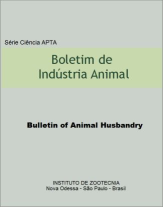Performance of heifers supplemented with different levels of corn on pasture
DOI:
https://doi.org/10.17523/bia.v73n3p260Keywords:
benefit-cost analysis, grazing, supplementation.Abstract
In southern Brazil, production systems are typically extensive and rely on grazing that often results in limited forage quantity and quality, decreasing efficiency and compromising reproductive tract development. The aim of this study was to evaluate the productive performance and reproductive tract development of heifers supplemented with different levels of corn on pasture. The following supplemental treatments were evaluated: T0 [40 g trace-mineralized salt per heifer per day (80 g phosphorus/kg product)]; T1 [0.5% of body weight (BW) cracked corn + 40 g trace-mineralized salt per heifer per day]; T2 [1% of BW cracked corn + 40 g trace-mineralized salt per heifer per day], and T3 [1.5% of BW cracked corn + 40 g trace-mineralized salt per heifer per day]. Thirty-nine phenotypically homogeneous Brangus heifers (average BW = 184±17 kg, average age = 269±27 days) raised on winter pasture (Lolium multiflorum Lam.) were randomized to 13 paddocks (one hectare each), with three heifers/paddock, to evaluate the effect of feeding different energy levels. Body condition score, average daily gain, frame score, dry matter availability, reproductive tract score, and stocking density were evaluated. The body condition score, average daily gain, reproductive tract score and stocking density increased (P<0.05) with increasing level of corn supplementation. Daily supplementation levels lower than 1.0% on Lolium multiflorum Lam. pasture can compromise the target breeding weight at 13 months of age. Therefore, daily supplementation at 1.0% of BW after weaning is a strategy to improve the economic and biological efficiency of livestock production systems, allowing to increase stocking density and to anticipate the age of heifers at first breeding.Downloads
Downloads
Published
Issue
Section
License
Os autores não serão remunerados pela publicação de trabalhos, pois devem abrir mão de seus direitos autorais em favor deste periódico. Por outro lado, os autores ficam autorizados a publicar seus artigos, simultaneamente, em repositórios da instituição de sua origem, desde que citada a fonte da publicação original seja Boletim de Indústria Animal. A revista se reserva o direito de efetuar, nos originais, alterações de ordem normativa, ortográfica e gramatical, com vistas a manter o padrão culto da língua e a credibilidade do veículo. Respeitará, no entanto, o estilo de escrever dos autores. Alterações, correções ou sugestões de ordem conceitual serão encaminhadas aos autores, quando necessário. Nesses casos, os artigos, depois de adequados, deverão ser submetidos a nova apreciação. As opiniões emitidas pelos autores dos artigos são de sua exclusiva responsabilidade. Todo o conteúdo deste periódico, exceto onde está identificado, está licenciado sob a Licença Creative Commons Attribution (CC-BY-NC). A condição BY implica que os licenciados podem copiar, distribuir, exibir e executar a obra e fazer trabalhos derivados com base em que só se dão o autor ou licenciante os créditos na forma especificada por estes. A cláusula NC significa que os licenciados podem copiar, distribuir, exibir e executar a obra e fazer trabalhos derivados com base apenas para fins não comerciais.













